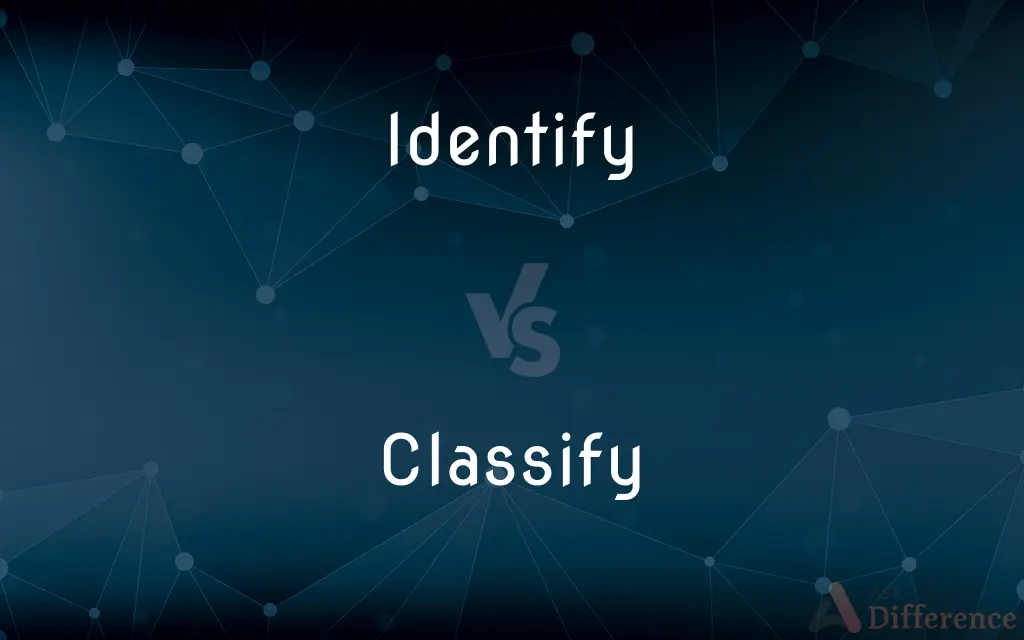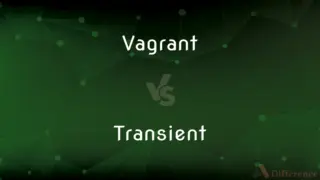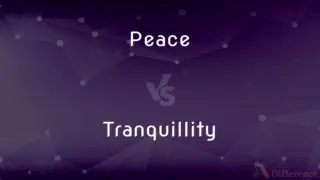Identify vs. Classify — What's the Difference?
Edited by Tayyaba Rehman — By Urooj Arif — Updated on April 8, 2024
Identify involves recognizing or establishing the identity of something, focusing on discovering its nature or essence, while classify means to sort or organize things into categories based on shared characteristics or criteria.

Difference Between Identify and Classify
Table of Contents
ADVERTISEMENT
Key Differences
Identifying something entails recognizing, discovering, or establishing what that thing is or determining its nature. It's about pinpointing or acknowledging the unique aspects or identity of an individual, object, or concept, often through observation or analysis. On the other hand, classifying involves sorting or organizing objects, individuals, or ideas into categories or groups based on shared characteristics, criteria, or properties. It's a process of grouping things together according to a systematic division to simplify understanding and communication.
When you identify something, you may be focusing on its unique features, such as its appearance, function, or any specific characteristics that distinguish it from others. This process is crucial in fields like biology, where identifying species is based on their unique traits, or in forensics, where identifying a person may involve fingerprints or DNA analysis. In contrast, classifying these entities would involve placing them into broader categories, like species in the case of biology or demographic groups in the case of population studies, based on common characteristics.
The act of identification is often the first step before classification can occur. Once something is identified and understood for its unique properties or essence, it can then be classified into a larger group that shares similar attributes. For example, in a library, a book is first identified by its title and author, and then it is classified into a genre or category that groups it with other books of similar content or style.
Identification can be subjective and based on personal perception or understanding, especially in fields like art or literature where the interpretation of identity might vary. Classification, however, strives for a more objective and standardized approach, using specific criteria or systems, such as the Dewey Decimal System in libraries or taxonomic ranks in biology, to ensure consistency and clarity in grouping.
Both identification and classification are fundamental processes in organizing information and knowledge. Identification allows for the recognition and understanding of the individuality and uniqueness of entities, while classification organizes these entities into understandable groups, making it easier to navigate and comprehend the complexity of the world around us.
ADVERTISEMENT
Comparison Chart
Definition
Recognizing or establishing the identity of something.
Sorting things into categories based on shared characteristics.
Focus
Uniqueness, individuality
Shared characteristics, grouping
Purpose
To understand or recognize something’s nature or essence.
To organize and simplify understanding through grouping.
Process
Observation, analysis to find unique traits.
Systematic division according to criteria or properties.
Application
Forensics, biology (species identification), personal recognition.
Taxonomy, library systems, data organization.
Outcome
Determination of something’s specific identity or characteristics.
Creation of categories or groups for easier reference and understanding.
Dependency
Can be standalone (just needing to recognize something).
Often relies on prior identification to accurately group entities.
Subjectivity/Objectivity
Can be more subjective (especially in arts, literature).
Strives for objectivity using specific criteria.
Compare with Definitions
Identify
Determining the nature or essence of something.
The app identifies songs based on a short audio clip.
Classify
Arranging information or objects for easier understanding and navigation.
The museum classifies exhibits by historical periods.
Identify
To recognize or establish what something is.
Scientists identified a new species in the rainforest.
Classify
Systematic division into groups for analysis or study.
Researchers classify survey responses by demographic characteristics.
Identify
Establishing the identity of an individual or object.
Biometric systems identify individuals through fingerprints.
Classify
Grouping entities together according to a system or criteria.
Scientists classify animals into taxonomic ranks.
Identify
Acknowledging or recognizing something’s presence or reality.
The teacher identified the need for more interactive learning tools.
Classify
Applying a structure or organization to simplify complex data.
Data scientists classify data into meaningful categories for analysis.
Identify
Pinpointing unique features or characteristics.
The detective identified the suspect based on eyewitness descriptions.
Classify
To sort or organize into categories based on shared characteristics.
The librarian classifies books according to their genres.
Identify
To establish or recognize the identity of; ascertain as a certain person or thing
Can you identify what kind of plane that is? I identified the man at the next table as a famous actor.
Classify
To arrange or organize according to class or category.
Identify
(Biology) To determine the taxonomic classification of (an organism).
Classify
To designate (a document, for example) as confidential, secret, or top secret.
Identify
To ascertain as having a certain characteristic or feature
Job candidates who are identified as overqualified.
Children who have been identified with hearing loss.
Classify
To identify by or divide into classes; to categorize
Should we classify "make up" as an idiom or as a phrasal verb?
Identify
To consider as identical or united; equate
The Greek god Ares is identified with the Roman god Mars.
Classify
To declare something a secret, especially a government secret
They decided to classify that information.
Identify
To associate or affiliate closely with
Writers who are identified with modernism.
Classify
To make classy
Identify
To consider oneself as sharing certain characteristics or attitudes as another
She identifies strongly with her grandmother.
Classify
To distribute into classes; to arrange according to a system; to arrange in sets according to some method founded on common properties or characters.
Identify
To associate oneself with or admire something, such as a set of ideas
A language learner who identifies with a new culture.
Classify
Arrange or order by classes or categories;
How would you classify these pottery shards--are they prehistoric?
Identify
(transitive) To establish the identity of someone or something.
It was hard to identify the shoplifter because the CCTV records didn't have a clear image.
Classify
Declare unavailable, as for security reasons;
Classify these documents
Identify
(transitive) To disclose the identity of someone.
The Associated Press will not identify the suspect of the crime because he is a juvenile.
Classify
Assign to a class or kind;
How should algae be classified?
People argue about how to relegate certain mushrooms
Identify
To establish the taxonomic classification of an organism.
Identify
(transitive) To equate or make the same; to unite or combine into one.
Identify
(reflexive) To have a strong affinity with; to feel oneself to be modelled on or connected to.
Identify
(intransitive) To associate oneself with some group; to feel, or believe one feels, the same way.
Identify
To claim an identity; to describe oneself as a member of a group; to assert the use of a particular term to describe oneself.
Identify
To make to be the same; to unite or combine in such a manner as to make one; to treat as being one or having the same purpose or effect; to consider as the same in any relation.
Every precaution is taken to identify the interests of the people and of the rulers.
Let us identify, let us incorporate ourselves with the people.
Identify
To establish the identity of; to prove to be the same with something described, claimed, or asserted; as, to identify stolen property.
Identify
To become the same; to coalesce in interest, purpose, use, effect, etc.
Identify
To coalesce in interest, purpose, use, effect, etc.; to associate oneself in name, goals, or feelings; usually used with with; as, he identified with the grief she felt at her father's death.
An enlightened self-interest, which, when well understood, they tell us will identify with an interest more enlarged and public.
Identify
Recognize as being; establish the identity of someone or something;
She identified the man on the 'wanted' poster
Identify
Give the name or identifying characteristics of; refer to by name or some other identifying characteristic property;
Many senators were named in connection with the scandal
The almanac identifies the auspicious months
Identify
Consider (oneself) as similar to somebody else;
He identified with the refugees
Identify
Identify as in botany or biology, for example
Identify
Consider to be equal or the same;
He identified his brother as one of the fugitives
Common Curiosities
What is the purpose of classification?
The purpose of classification is to organize and group entities based on shared characteristics to simplify understanding, navigation, and communication of complex information.
Why is identification important?
Identification is crucial for understanding the unique aspects of an entity, which can be essential in fields such as biology, medicine, and forensics for accurate recognition and analysis.
What are common criteria used in classification?
Common criteria for classification include physical characteristics, genetic makeup, function, purpose, or any other defining features that allow entities to be grouped together meaningfully.
How is classifying different from identifying?
Classifying involves sorting or organizing entities into groups or categories based on shared characteristics, after they have been identified, whereas identifying is about recognizing the unique features or essence of an individual or object.
Can you classify without identifying first?
Typically, identification is a prerequisite for accurate classification, as it establishes the unique characteristics that inform which category or group an entity belongs to.
Is identification always accurate?
While identification aims to be as accurate as possible, it can sometimes be challenging due to factors like limited information, subjective interpretation, or the complexity of the entity being identified.
Can classification systems change?
Yes, classification systems can evolve as new information becomes available or as understanding of entities deepens, requiring updates to how things are grouped or categorized.
What role does identification play in security?
In security, identification is crucial for verifying individuals' identities, ensuring only authorized access to information, facilities, or systems, and preventing fraud or unauthorized entry.
What does it mean to identify something?
To identify something means to recognize, determine, or establish its identity or nature, focusing on its unique aspects or characteristics.
How does technology aid in identification?
Technology, such as biometric systems, DNA analysis, and artificial intelligence, enhances identification by providing precise, accurate, and rapid recognition capabilities, even in complex scenarios.
What is the difference between identification and diagnosis?
While identification involves recognizing or determining the nature of something, diagnosis specifically refers to determining the nature of a problem, typically within a medical or technical context, based on symptoms or signs.
Can something belong to multiple classes?
Yes, an entity can belong to multiple classes if it shares characteristics with different groups, especially in more complex or interdisciplinary classification systems.
Share Your Discovery

Previous Comparison
Vagrant vs. Transient
Next Comparison
Peace vs. TranquillityAuthor Spotlight
Written by
Urooj ArifUrooj is a skilled content writer at Ask Difference, known for her exceptional ability to simplify complex topics into engaging and informative content. With a passion for research and a flair for clear, concise writing, she consistently delivers articles that resonate with our diverse audience.
Edited by
Tayyaba RehmanTayyaba Rehman is a distinguished writer, currently serving as a primary contributor to askdifference.com. As a researcher in semantics and etymology, Tayyaba's passion for the complexity of languages and their distinctions has found a perfect home on the platform. Tayyaba delves into the intricacies of language, distinguishing between commonly confused words and phrases, thereby providing clarity for readers worldwide.













































